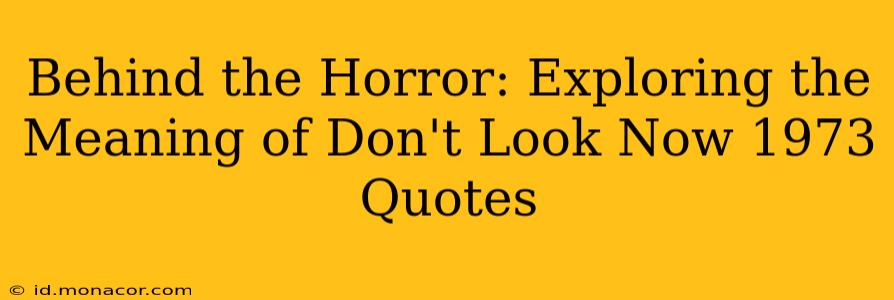Nicolas Roeg's Don't Look Now (1973) isn't just a horror film; it's a masterclass in unsettling ambiguity, leaving viewers grappling with its haunting imagery and cryptic dialogue long after the credits roll. The film's power lies not only in its chilling atmosphere but also in the potency of its quotes, which resonate with layers of meaning related to grief, guilt, premonition, and the fragility of reality. This exploration delves into some of the most memorable lines, examining their context and the interpretations they evoke.
"It's the way they look at you."
This seemingly simple line, uttered by the mysterious blind woman, is laden with significance. It speaks to the unsettling gaze of the seemingly supernatural occurrences that plague John and Laura Baxter throughout the film. The "look" isn't simply a visual observation; it represents a profound sense of being watched, judged, and perhaps even manipulated by forces beyond their comprehension. The ambiguity of the statement enhances its impact—are they being watched by spirits, or is the unsettling feeling rooted in their own subconscious grief and guilt? This question lingers, reflecting the film's refusal to offer easy answers.
"He's got a red coat."
This seemingly insignificant detail, repeatedly mentioned in connection with the little girl's vision of the man in red, becomes increasingly chilling throughout the film. The red coat acts as a visual symbol of impending doom, a recurring motif that links the seemingly disparate events together and heightens the suspense. Its symbolic power lies in its stark contrast to the muted tones of Venice, making it a potent visual signal of danger and foreshadowing tragedy. The repetition of this phrase underscores the growing sense of unease and the Baxters' inability to shake off the ominous premonition.
"Is it something you should talk about, or something you should just feel?"
This line encapsulates the film's central theme: the delicate balance between rational explanation and the intangible realm of grief and premonition. The film expertly navigates the space between rational understanding and the uncanny, inviting viewers to question the nature of reality and the limits of human perception. Is the experience they're having rooted in something tangible, or is it purely a manifestation of their internal struggles with loss and trauma? The quote itself leaves the question open, reflecting the film's masterful ambiguity.
What is the significance of the Venice setting in Don't Look Now?
Venice, with its labyrinthine canals, shadowy alleyways, and palpable sense of history, serves as the perfect backdrop for the film's unsettling atmosphere. Its romantic beauty is juxtaposed with the growing sense of dread and foreboding, highlighting the film's thematic exploration of the fragility of beauty and the insidious nature of grief. The city's ambiguity, its blend of enchantment and decay, mirrors the ambiguous nature of the supernatural events that unfold within it.
What are the main themes of Don't Look Now?
Don't Look Now explores several profound themes: grief and loss, the fragility of reality, the power of premonition, the nature of faith and spirituality, and the complexities of human relationships in the face of trauma. The film doesn't offer simple solutions or easy answers; instead, it delves into the murky depths of human experience, leaving viewers to ponder the ambiguous nature of what they've witnessed.
Is Don't Look Now a supernatural horror film?
The film’s supernatural elements are presented ambiguously, intentionally leaving the audience questioning whether the events are paranormal or rooted in the characters' psychological states. This intentional ambiguity contributes significantly to the film's lasting impact and encourages multiple interpretations. The film’s power comes from its ability to blur the lines between the natural and the supernatural, leaving the viewer to determine the truth for themselves.
What is the meaning of the ending of Don't Look Now?
The film's ambiguous ending is a source of considerable debate amongst viewers. The final scene, where John is seemingly murdered or otherwise fatally attacked, leaves the interpretation open to the viewer. Is it a supernatural act of vengeance, a manifestation of John’s grief and guilt, or perhaps an entirely different interpretation? This ambiguity mirrors the film's overarching theme of uncertainty and the limitations of human perception. The lack of a definitive answer is precisely what makes the ending so potent and unforgettable.
In conclusion, Don't Look Now's enduring power stems from its refusal to provide easy answers. The film's cryptic quotes, unsettling imagery, and ambiguous narrative create a haunting experience that lingers long after the credits roll. By exploring the complexities of grief, premonition, and the boundaries of reality, Roeg crafted a masterpiece of psychological horror that continues to fascinate and unsettle audiences today.

